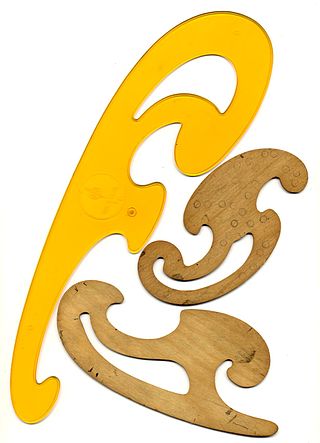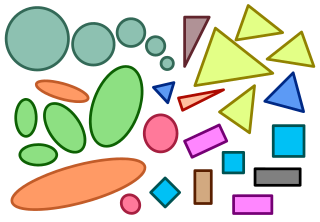
A ruler, sometimes called a rule, scale or a line gauge, is an instrument used to make length measurements, whereby a user estimates a length by reading from a series of markings called "rules" along an edge of the device. Commonly the instrument is rigid and the edge itself is a straightedge, which additionally allows one to draw straight lines. Some rulers, such as cloth or paper tape measures, are non-rigid. Specialty rulers exist that have flexible edges that retain a chosen shape; these find use in sewing, arts, and crafts.

An engineering drawing is a type of technical drawing that is used to convey information about an object. A common use is to specify the geometry necessary for the construction of a component and is called a detail drawing. Usually, a number of drawings are necessary to completely specify even a simple component. These drawings are linked together by a "master drawing." This "master drawing" is more commonly known as an assembly drawing. The assembly drawing gives the drawing numbers of the subsequent detailed components, quantities required, construction materials and possibly 3D images that can be used to locate individual items. Although mostly consisting of pictographic representations, abbreviations and symbols are used for brevity and additional textual explanations may also be provided to convey the necessary information.

In contemporary education, mathematics education—known in Europe as the didactics or pedagogy of mathematics—is the practice of teaching, learning, and carrying out scholarly research into the transfer of mathematical knowledge.

A French curve is a template usually made from metal, wood or plastic composed of many different curved segments. It is used in manual drafting and in fashion design to draw smooth curves of varying radii. The curve is placed on the drawing material, and a pencil, knife or other implement is traced around its curves to produce the desired result. They were invented by the German mathematician Ludwig Burmester and are also known as Burmester (curve) set.

New Mathematics or New Math was a dramatic but temporary change in the way mathematics was taught in American grade schools, and to a lesser extent in European countries and elsewhere, during the 1950s–1970s.
Principles and Standards for School Mathematics (PSSM) are guidelines produced by the National Council of Teachers of Mathematics (NCTM) in 2000, setting forth recommendations for mathematics educators. They form a national vision for preschool through twelfth grade mathematics education in the US and Canada. It is the primary model for standards-based mathematics.

Elementary mathematics, also known as primary or secondary school mathematics, is the study of mathematics topics that are commonly taught at the primary or secondary school levels around the world. It includes a wide range of mathematical concepts and skills, including number sense, algebra, geometry, measurement, and data analysis. These concepts and skills form the foundation for more advanced mathematical study and are essential for success in many fields and everyday life. The study of elementary mathematics is a crucial part of a student's education and lays the foundation for future academic and career success.

A set square or triangle is an object used in engineering and technical drawing, with the aim of providing a straightedge at a right angle or other particular planar angle to a baseline.
Selectividad is the popular name given to the Spanish University Admission Tests, a non-compulsory exam taken by students after secondary school, necessary to get into University. Students must take six 90-minute written exams over three days in June or September, consisting of common and specific subjects taken in "Bachillerato". Selectividad exams are set by the Public Universities of each autonomous community and allow students access to the Spanish university system.
In mathematics education, the Van Hiele model is a theory that describes how students learn geometry. The theory originated in 1957 in the doctoral dissertations of Dina van Hiele-Geldof and Pierre van Hiele at Utrecht University, in the Netherlands. The Soviets did research on the theory in the 1960s and integrated their findings into their curricula. American researchers did several large studies on the van Hiele theory in the late 1970s and early 1980s, concluding that students' low van Hiele levels made it difficult to succeed in proof-oriented geometry courses and advising better preparation at earlier grade levels. Pierre van Hiele published Structure and Insight in 1986, further describing his theory. The model has greatly influenced geometry curricula throughout the world through emphasis on analyzing properties and classification of shapes at early grade levels. In the United States, the theory has influenced the geometry strand of the Standards published by the National Council of Teachers of Mathematics and the Common Core Standards.

Core-Plus Mathematics is a high school mathematics program consisting of a four-year series of print and digital student textbooks and supporting materials for teachers, developed by the Core-Plus Mathematics Project (CPMP) at Western Michigan University, with funding from the National Science Foundation. Development of the program started in 1992. The first edition, entitled Contemporary Mathematics in Context: A Unified Approach, was completed in 1995. The third edition, entitled Core-Plus Mathematics: Contemporary Mathematics in Context, was published by McGraw-Hill Education in 2015.

A spline consists of a long strip fixed in position at a number of points whose tension creates a smooth curve passing through those points, for the purpose of transferring that curve to another material.

Drafting tools may be used for measurement and layout of drawings, or to improve the consistency and speed of creation of standard drawing elements. Tools such as pens and pencils mark the drawing medium. Other tools such as straight edges, assist the operator in drawing straight lines, or assist the operator in drawing complicated shapes repeatedly. Various scales and the protractor are used to measure the lengths of lines and angles, allowing accurate scale drawing to be carried out. The compass is used to draw arcs and circles. A drawing board was used to hold the drawing media in place; later boards included drafting machines that sped the layout of straight lines and angles. Tools such as templates and lettering guides assisted in the drawing of repetitive elements such as circles, ellipses, schematic symbols and text. Other auxiliary tools were used for special drawing purposes or for functions related to the preparation and revision of drawings. The tools used for manual technical drawing have been displaced by the advent of computer-aided drawing, drafting and design (CADD).

A mathematical instrument is a tool or device used in the study or practice of mathematics. In geometry, construction of various proofs was done using only a compass and straightedge; arguments in these proofs relied only on idealized properties of these instruments and literal construction was regarded as only an approximation. In applied mathematics, mathematical instruments were used for measuring angles and distances, in astronomy, navigation, surveying and in the measurement of time.

Helix is a United Kingdom-based manufacturer of stationery. It exports to over 65 countries, with offices in Hong Kong and US, and has its UK headquarters in Kingswinford in the West Midlands.
Modern elementary mathematics is the theory and practice of teaching elementary mathematics according to contemporary research and thinking about learning. This can include pedagogical ideas, mathematics education research frameworks, and curricular material.
A mathematical exercise is a routine application of algebra or other mathematics to a stated challenge. Mathematics teachers assign mathematical exercises to develop the skills of their students. Early exercises deal with addition, subtraction, multiplication, and division of integers. Extensive courses of exercises in school extend such arithmetic to rational numbers. Various approaches to geometry have based exercises on relations of angles, segments, and triangles. The topic of trigonometry gains many of its exercises from the trigonometric identities. In college mathematics exercises often depend on functions of a real variable or application of theorems. The standard exercises of calculus involve finding derivatives and integrals of specified functions.

The C-Thru Ruler Company is an American maker of measuring devices and specialized products for drafting, designing and drawing. The company was formed in 1939 in Bloomfield, Connecticut, by Jennie R. Zachs, a schoolteacher, who saw the need for transparent measuring tools such as rulers, triangles, curves and protractors.

A Lénárt sphere is a educational manipulative and writing surface for exploring spherical geometry, invented by Hungarian István Lénárt as a modern replacement for a spherical blackboard. It can be used for visualizing the geometry of points, great and small circles, triangles, polygons, conics, and other objects on a sphere, and comparing spherical geometry to Euclidean geometry as drawn on a flat piece of paper or blackboard. The included spherical ruler and compass support synthetic straightedge and compass construction on the sphere.
Origamics: Mathematical Explorations Through Paper Folding is a book on the mathematics of paper folding by Kazuo Haga, a Japanese retired biology professor. It was edited and translated into English by Josefina C. Fonacier and Masami Isoda, based on material published in several Japanese-language books by Haga, and published in 2008 by World Scientific. The title is a portmanteau of "origami" and "mathematics", coined in the 1990s by Haga to describe the type of paper-folding mathematical exploration that would later be described in this book.














